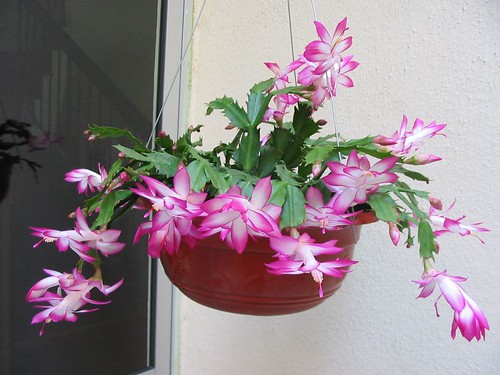Woo hoo!! I'm so overjoyed! Finally, I've managed to name this beauty with help from the gardening forum which I joined less than a week ago. It's commonly known as Zygocactus or Christmas/Thanksgiving Cactus or Crab's Claw Cactus. Its botanical name is Schlumbergera truncata (whew! what a tongue twister, so difficult to pronouce!). My lovely plant is named Schlumbergera x Bristol Beauty or Thanksgiving Cactus.

I was mersmerised by its blooms when I bought it last August and had seeked eagerly but unsuccessfully until now from the web to know its name. "Sigh" - doing it the wrong way! I should have joined a gardening forum sooner and not procrastinate instead! There's where all the gardening 'gurus' are. Well, it's never too late to learn :)
Experimenting with this easy-growing cactus which is actually an epiphyte originated from the jungles of southeast Brazil, as well as gathering info from websites resulted in the following plant details which I'd like to share with other garden enthusiasts:
Climate: cool temperate or warm tropical
Sun exposure: partial shade with morning sun, bright indirect light though not too much night-time artificial light when budding
Water requirement: moderate watering (less after flowering), occasional spraying on leaves
Soil: preferably a potting mixture of one part of peat and one part of coarse sand for good drainage; (also, a suggestion to use orchid mix since it’s an epiphyte? - :) don’t know whether this will succeed!)
Height: 1 – 1½ feet
Foliage: evergreen, segmented leaves forking into branches
Bloom color: range from pink, lavender, scarlet red through to orange, yellow and white (single or multiple toned)
Bloom time: end of autumn until late spring, especially during Christmas (thus named ‘Christmas Cactus’ for its blooming season)
Propagation: easily from leaf cuttings. Break off leaf segments preferably those with aerial roots and allow to dry out for a couple of hours. Place a single segment or one with at least three joints into your soil mix, pushing the bottom segment into the soil. Place a few into one pot and maintain as you would a mature plant.
Other details: suitable as indoor plants, for hanging baskets or tall pots. Prone to wilt diseases, root rot if overwatered and spider mites.
I'm now waiting eagerly for my new plants to display its magnificent blooms. Meanwhile enjoy!
Happy gardening to all garden enthusiasts!!



No comments:
Post a Comment